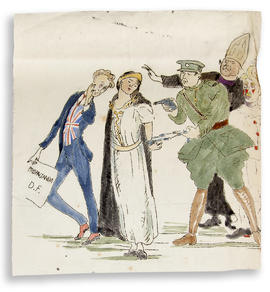A volume containing copy and draft correspondence of Fr. Senan Moynihan OFM Cap. The file contains copies of his personal letters and correspondence relating to the Capuchin Publications Office. Some of the correspondence refers to the ‘Orange Terror’ article originally published in ‘The Capuchin Annual’ while other letters reference the artwork of Jack B. Yeats and Richard King, and contemporary political matters. Includes Fr. Senan’s copy letters to Seumas MacManus, Michael O’Higgins, Joseph O’Connor (Seosamh Ó Conchubhair), Lily McCormack (provides his recollections of the funeral of John McCormack, 8 Jan. 1948), Aodh de Blacam, Bishop John Dignan, Thomas MacGreevy, Alan C. Macauley (Sierra Madre, California), Domhnall Ó Corcora (Daniel Corkery), Archbishop Redmond Prendiville, Patrick John Little, Myles O’Farrell, Pádraig De Brún, Fr. Jerome Hawes TOSF (Mount Alvernia Hermitage, Cat Island, Bahamas), General Aodh MacNeill, Maud Gonne MacBride, Archbishop Sylvester Mulligan OFM Cap., Thomas R. Lynch (South Hill Street, Los Angeles), Delia Murphy (refers to her performance at concert in aid of the Carl Hardebeck fund in Belfast, 4 Oct. 1945), Fr. Donal O’Connor, Seán Moylan, Seán T. O’Kelly, Gerald Boland (Minister of Justice), Edith M. Scott Mason, Frank E. Benner, Frieda Le Pla, Hubert Rooney, Jack B. Yeats, Oscar Traynor (Minister of Defence), Ellen O’Grady (Tralee, County Kerry), Tomás S. Cuffe, Peter F. Anson, Sir Shane Leslie, Fr. John Brosnan (St. Mary’s Church, Los Angeles), Éamon de Valera, Victor Waddington, Fr. Hugh Morley OFM Cap. (editor, ‘The Cowl / A Capuchin Review’), Sara Allgood, Richard James Hayes, David Marcus, T.J. Kiernan (Irish Legation, Canberra, Australia), Michael McDunphy (Director of Bureau of Military History, refers to McDunphy’s hopes of obtaining recollections of the 1916 Rising from Fr. Columbus Murphy OFM Cap., Fr. Augustine Hayden OFM Cap., Fr. Aloysius Travers OFM Cap. and Archbishop Sylvester Mulligan OFM Cap., 19 Sept. 1947), Fr. Eugene Carroll OFM Cap., Sister M. Gertrude (Missionary Sisters of St. Columban, Cahiracon, Ennis, County Clare), Philip F. Roden (Emory Street, Jersey City, United States), Seamus de Faoite, Germaine Stockley, Kathleen M. Murphy, Séamus Campbell, Fr. Henry S. Glendon OP (Holy Cross Church, Tralee, County Kerry, refers to the artist Michael Healy), Fr. Thomas O’Donnell CM (Rector, All Hallows College, Dublin), Sophie Raffalovich O'Brien, Fr. Frank Moynihan (Nazareth House, Hammersmith, London), Fr. Terence L. Connolly SJ, Frank Fahy, James Mason (English actor, 1909-1984), Francis McCullagh, Fr. Edward J. Kissane (President, Saint Patrick’s College, Maynooth), Eleanor Barnes (Lady Yarrow), H. Lytton Wilson (Secretary, The F.J. McCormick Memorial Committee), Fr. Donal Herlihy (Pontifical Irish College, Rome), James McGurrin (President, American Irish Historical Society, New York, refers to the purpose and ethos of the ‘Annual’ and need for support from patrons in the United States, 2 Feb. 1948), Colin Summerford, Mary Hardebeck, Fr. J.F. Forde (Diocesan Inspector, Cathedral Presbytery, Cork), Eduard Hempel (refers to the case of Kurt Von Burgsdorff, former Governor of Kraków, Poland), Fr. Louis A. Gales (Catechetical Guild, Minnesota), Jarlath A. O’Connell, Mary O’Connell (‘The Advocate’, Beckett Street, Melbourne), Vincent Evans, Benedict Kiely, Ernest Musgrave (Director, City Art Gallery, Leeds, referring to a loan of ‘The old road, Dungarvan’ (1925) by Jack B. Yeats, 23 Apr. 1948), Michael Lennon (Healthfield Road, Terenure, Dublin), Fr. Henry Edward George Rope, Francis J. Little (Rathgar Road, Dublin), Ellen McCann (15 Tower Hill, Armagh), Frederick May, Clare Sheridan, Richard King, Richard Hayward, G.F. Troup Horne (Birbeck College, London), and Bishop William MacNeely.

